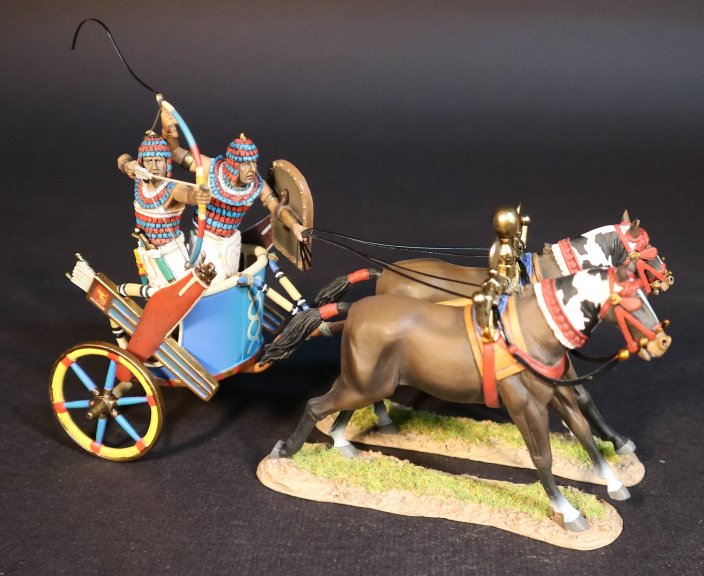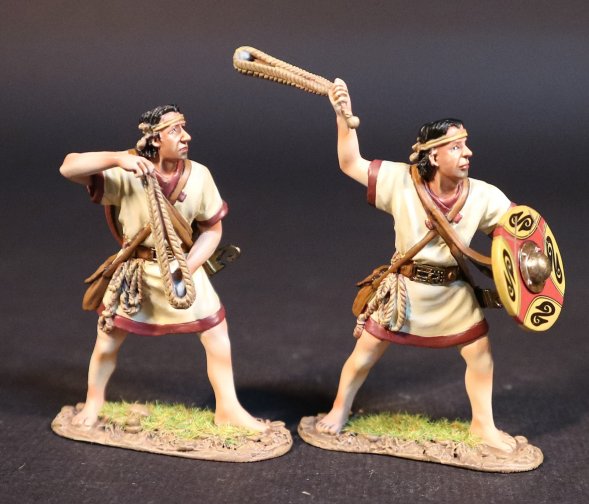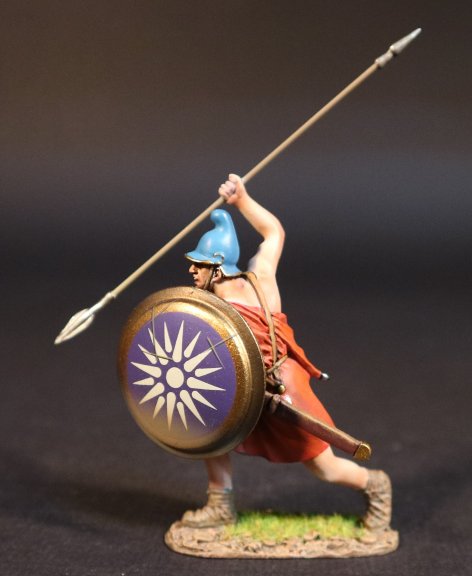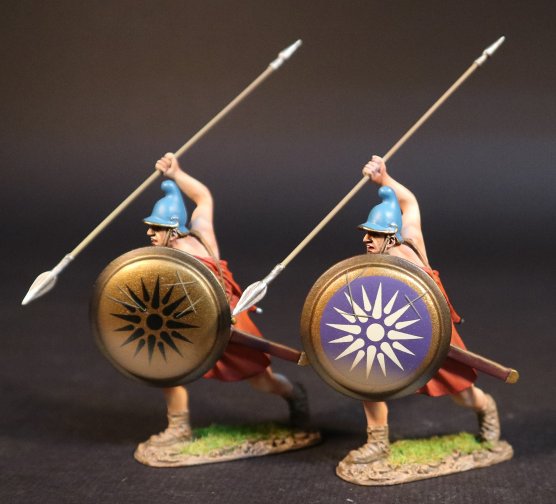- Joined
- Feb 2, 2011
- Messages
- 2,339
NEW RELEASES FOR JUNE 2024
THE ANCIENTS
NEW KINGDOM EGYPTIANS
The New Kingdom, is the period in ancient Egyptian history between the sixteenth century BC and the eleventh century BC. It was Egypt’s most prosperous time and marked the peak of its power.
It is also known as the “Ramesside period”, named after the eleven pharaohs who took the name Ramesses, after Ramesses I, the founder of the nineteenth Dynasty.

Ancient Egyptian chariots, emblematic of the power and prestige of the New Kingdom period (c. 1550-1070 BCE), were an integral part of the military and cultural fabric of the time.

NKE-03
THE ANCIENTS,
NEW KINGDOM EGYPTIANS,
THE BATTLE OF KADESH 1274BC,
EGYPTIAN WAR CHARIOT
The introduction of chariots to Egypt occurred during the Second Intermediate Period (c. 1650-1550 BCE), a time marked by the decline of the Middle Kingdom and the fragmentation of Egyptian power.
During this period, the Hyksos, a Semitic-speaking people from Western Asia, migrated to and settled in the Nile Delta.
They eventually established their rule over the northern part of Egypt, creating the 15th Dynasty.
The Hyksos brought with them advanced technology and innovations, including the horse-drawn chariot and the composite bow.
These technological advancements provided them with a significant military edge, enabling them to maintain control over their newly acquired territories.
As they assimilated into the local culture, they also introduced these innovations to the Egyptian population.
The Egyptian elite adopted the chariot as a symbol of power, prestige, and divine favor.
Under the reign of Ahmose I (c. 1539-1514 BCE), the founder of the 18th Dynasty and the New Kingdom, the Egyptians successfully drove the Hyksos out of Egypt.
This victory was partly due to their effective use of chariots, which allowed them to match and surpass the Hyksos in battle.
In the New Kingdom, the Egyptian chariots were further refined and optimized for their specific needs.
They became lighter, faster, and more maneuverable, with a design that prioritized the use of archers in battle.
They were typically made from wood, with some parts fashioned from leather and bronze.
The yoke and harness system connected the chariot to the horses. The yoke was a wooden crossbar placed across the necks of the horses, with a central pole extending from it to the chariot.
The golden age of the Egyptian chariot coincided with the New Kingdom (c. 1550-1070 BCE), a period marked by the resurgence of Egyptian power and the expansion of its empire.
These versatile vehicles enabled Egypt's New Kingdom pharaohs to project their power across vast territories and solidify their status as rulers of a mighty empire.
Today, the chariot remains an enduring symbol of ancient Egypt's military prowess and cultural sophistication.
ARMIES AND ENEMIES OF ANCIENT ROME
THE CARTHAGINIANS
THE BATTLE OF ZAMA 202BC
BALEARIC SLINGERS
The Balearic slingers launched bullets that had a speed of 160 kilometers per hour (one hundred miles per hour). They could hit their opponents at a distance of 400 meters (1,300 feet) but were deadliest at a distance of 120 meters (400 feet).
An experienced slinger could make seven shots per minute.
They carried three slings, one around their head, one around their waist, and the third in their hands. Different slings were used to hit targets at different distances. The longer the sling, the larger distance it could cover.

CTSK-04
ARMIES AND ENEMIES OF ANCIENT ROME,
THE CARTHAGINIANS,
THE BATTLE OF ZAMA 202BC,
BALEARIC SLINGERS
They manufactured the bullets for slings from stone, lead, or clay.
Some sling bullets had holes to give off a buzzing sound, reminiscent of an agitated wasp. This was an ancient form of psychological warfare.
Often, the bullets contained inscriptions and images. The most common were the images of a lightning bolt, a snake, or a scorpion. Some bullets had inscriptions such as: “Take this”, “Catch”, “Ouch”, or “Get pregnant with this.

CTSK-04N
ARMIES AND ENEMIES OF ANCIENT ROME,
THE CARTHAGINIANS,
THE BATTLE OF ZAMA 202BC,
BALEARIC SLINGERS
The Balearic Islands are a Spanish archipelago in the Mediterranean Sea. Today, these islands are best known as tourist destinations, with the islands of Ibiza and Mallorca being especially popular.
However, in antiquity, the Balearic Islands were best known for the deadliest slingers in the Mediterranean.
The Balearic slingers were a coveted asset of every army of antiquity.
The name for the Balearic Islands originated from the Greek word “ballo” which means “to launch.”
The Balearic slingers started training as soon as they could walk. Supposedly, mothers didn’t give their children food until they could hit their targets.
Years and years of practice made slinging their second nature and turned these slingers into game-changing warriors on the battlefield.
During the second Punic War (218-201BC) the Carthaginian master general Hannibal wreaked havoc in Roman Italy. The Romans were terrified of the invisible killers, the Balearic slingers.
The Carthaginians recognized the skill of the slingers and tried to hire as many of them as possible. Interestingly the slingers didn’t want gold, they demanded to be paid with wine and women.
Once the Romans defeated the Carthaginians they made sure that the Balearic slingers became part of the auxiliary units of the Roman legions.
The use of slings slowly faded away. It took years and years of practice to train warriors to efficiently use this weapon. In the Middle Ages, bowmen required less effort to train than slingers. Eventually, bows were replaced by firearms, the usage of which could be taught in a matter of weeks.
We could say technological advancement made the Balearic slingers obsolete. However, history will remember them for their skills, terrifying reputation, and admiration from foes and friends alike.
THE TROJAN WAR
TROY AND HER ALLIES
The Trojan army defending the great city of Troy, led by their king Priam, had assistance from a long list of allies. These included the Lycians, which was a maritime district in south western Anatolia (now Turkey). It was situated along the Mediterranean coast between Caria and Pamphylia, and extended inland to the ridge of the Taurus Mountains.
EURYPYLUS - PRINCE OF MYSIA
Euryplyus was the son of Telephus, King of Mysia. He was a great warrior, who led a Mysian contingent that fought alongside the Trojans against the Greeks in the Trojan War.
In a prelude to the Trojan War, the Greeks attacked Mysia, mistaking it for Troy. Eurypylus’ father Telephus was wounded by Achilles and later, when his wound continued to fester, was also healed by Achilles. According to some accounts, because of this, Telephus promised that neither he nor his familt would aid the Trojans in the coming war.
Nevertheless, during the final stages of the war, between the death of Achilles, and the ruse of the Trojan horse, Eurypylus led a large Mysian force to fight on the side of Troy. Some accounts state that Priam obtained Eurypylus’ aid in the war by giving his mother Astyoche a golden vine, or by promising Eurypylus one of his daughters as a wife.


TWT-11
THE TROJAN WAR,
TROY AND HER ALLIES,
EURYPYLUS, PRINCE OF MYSIA.
Eurypylus was a great warrior and killed many opponents, including Machaon, Nireus, and Peneleus.
Neoptolemus finally killed Eurypylus, using the same spear that his father Achilles had used to both wound and heal Eurypylus’ father Telephus.
Homer has Odysseus say that Eurypylus was, next to Memnon, the most beautiful man he had ever seen, and there were nearly one hundred lines of the poem devoted to a detailed description of Eurypylus’ shield, which was adorned with depictions of the twelve labours of Hercules.
Dressed for battle, Eurypylus "seemed the War-god"
THE ARMIES AND ENEMIES OF GREECE AND MACEDONIA
MACEDONIAN HYPASPISTS

The Macedonian Hypaspists were positioned on the flank of the Phalangites phalanx.
Their own flanks were protected by light infantry and cavalry.
Their job was to guard the flanks of the large and unwieldy pike phalanx. The armoured phalangites with their sarissas were not particularly agile or able to turn quickly, so hypaspists were positioned to prevent and protect attacks on the vulnerable sides of the phalanx formation.
Their role was vital to the success of the Macedonian tactics because the phalanx was all but invulnerable from the front, and with its layers of iron spikes moving in unison, were used as the anvil in their hammer and anvil tactics. The Companion cavalry was the hammer that smashed the enemy against the anvil of thousands of iron spikes.

MAC-31A
ARMIES AND ENEMIES OF ANCIENT GREECE AND MACEDONIA,
THE MACEDONIANS,
MACEDONIAN HYPASPIST
The Hypaspists protected the vulnerable phalanx flank, and were able to conduct maneuvers and use tactics, which owing to their hoplite panoply of weapons, would have been impossible to be performed by the phalangites.

MAC-31B
ARMIES AND ENEMIES OF ANCIENT GREECE AND MACEDONIA,
THE MACEDONIANS,
MACEDONIAN HYPASPIST

MAC-31D
ARMIES AND ENEMIES OF ANCIENT GREECE AND MACEDONIA,
THE MACEDONIANS,
MACEDONIAN HYPASPISTS
** PLEASE CONTACT YOUR LOCAL DEALER FOR FURTHER INFORMATION **
THE ANCIENTS
NEW KINGDOM EGYPTIANS
The New Kingdom, is the period in ancient Egyptian history between the sixteenth century BC and the eleventh century BC. It was Egypt’s most prosperous time and marked the peak of its power.
It is also known as the “Ramesside period”, named after the eleven pharaohs who took the name Ramesses, after Ramesses I, the founder of the nineteenth Dynasty.

Ancient Egyptian chariots, emblematic of the power and prestige of the New Kingdom period (c. 1550-1070 BCE), were an integral part of the military and cultural fabric of the time.

NKE-03
THE ANCIENTS,
NEW KINGDOM EGYPTIANS,
THE BATTLE OF KADESH 1274BC,
EGYPTIAN WAR CHARIOT
The introduction of chariots to Egypt occurred during the Second Intermediate Period (c. 1650-1550 BCE), a time marked by the decline of the Middle Kingdom and the fragmentation of Egyptian power.
During this period, the Hyksos, a Semitic-speaking people from Western Asia, migrated to and settled in the Nile Delta.
They eventually established their rule over the northern part of Egypt, creating the 15th Dynasty.
The Hyksos brought with them advanced technology and innovations, including the horse-drawn chariot and the composite bow.
These technological advancements provided them with a significant military edge, enabling them to maintain control over their newly acquired territories.
As they assimilated into the local culture, they also introduced these innovations to the Egyptian population.
The Egyptian elite adopted the chariot as a symbol of power, prestige, and divine favor.
Under the reign of Ahmose I (c. 1539-1514 BCE), the founder of the 18th Dynasty and the New Kingdom, the Egyptians successfully drove the Hyksos out of Egypt.
This victory was partly due to their effective use of chariots, which allowed them to match and surpass the Hyksos in battle.
In the New Kingdom, the Egyptian chariots were further refined and optimized for their specific needs.
They became lighter, faster, and more maneuverable, with a design that prioritized the use of archers in battle.
They were typically made from wood, with some parts fashioned from leather and bronze.
The yoke and harness system connected the chariot to the horses. The yoke was a wooden crossbar placed across the necks of the horses, with a central pole extending from it to the chariot.
The golden age of the Egyptian chariot coincided with the New Kingdom (c. 1550-1070 BCE), a period marked by the resurgence of Egyptian power and the expansion of its empire.
These versatile vehicles enabled Egypt's New Kingdom pharaohs to project their power across vast territories and solidify their status as rulers of a mighty empire.
Today, the chariot remains an enduring symbol of ancient Egypt's military prowess and cultural sophistication.
ARMIES AND ENEMIES OF ANCIENT ROME
THE CARTHAGINIANS
THE BATTLE OF ZAMA 202BC
BALEARIC SLINGERS
The Balearic slingers launched bullets that had a speed of 160 kilometers per hour (one hundred miles per hour). They could hit their opponents at a distance of 400 meters (1,300 feet) but were deadliest at a distance of 120 meters (400 feet).
An experienced slinger could make seven shots per minute.
They carried three slings, one around their head, one around their waist, and the third in their hands. Different slings were used to hit targets at different distances. The longer the sling, the larger distance it could cover.

CTSK-04
ARMIES AND ENEMIES OF ANCIENT ROME,
THE CARTHAGINIANS,
THE BATTLE OF ZAMA 202BC,
BALEARIC SLINGERS
They manufactured the bullets for slings from stone, lead, or clay.
Some sling bullets had holes to give off a buzzing sound, reminiscent of an agitated wasp. This was an ancient form of psychological warfare.
Often, the bullets contained inscriptions and images. The most common were the images of a lightning bolt, a snake, or a scorpion. Some bullets had inscriptions such as: “Take this”, “Catch”, “Ouch”, or “Get pregnant with this.

CTSK-04N
ARMIES AND ENEMIES OF ANCIENT ROME,
THE CARTHAGINIANS,
THE BATTLE OF ZAMA 202BC,
BALEARIC SLINGERS
The Balearic Islands are a Spanish archipelago in the Mediterranean Sea. Today, these islands are best known as tourist destinations, with the islands of Ibiza and Mallorca being especially popular.
However, in antiquity, the Balearic Islands were best known for the deadliest slingers in the Mediterranean.
The Balearic slingers were a coveted asset of every army of antiquity.
The name for the Balearic Islands originated from the Greek word “ballo” which means “to launch.”
The Balearic slingers started training as soon as they could walk. Supposedly, mothers didn’t give their children food until they could hit their targets.
Years and years of practice made slinging their second nature and turned these slingers into game-changing warriors on the battlefield.
During the second Punic War (218-201BC) the Carthaginian master general Hannibal wreaked havoc in Roman Italy. The Romans were terrified of the invisible killers, the Balearic slingers.
The Carthaginians recognized the skill of the slingers and tried to hire as many of them as possible. Interestingly the slingers didn’t want gold, they demanded to be paid with wine and women.
Once the Romans defeated the Carthaginians they made sure that the Balearic slingers became part of the auxiliary units of the Roman legions.
The use of slings slowly faded away. It took years and years of practice to train warriors to efficiently use this weapon. In the Middle Ages, bowmen required less effort to train than slingers. Eventually, bows were replaced by firearms, the usage of which could be taught in a matter of weeks.
We could say technological advancement made the Balearic slingers obsolete. However, history will remember them for their skills, terrifying reputation, and admiration from foes and friends alike.
THE TROJAN WAR
TROY AND HER ALLIES
The Trojan army defending the great city of Troy, led by their king Priam, had assistance from a long list of allies. These included the Lycians, which was a maritime district in south western Anatolia (now Turkey). It was situated along the Mediterranean coast between Caria and Pamphylia, and extended inland to the ridge of the Taurus Mountains.
EURYPYLUS - PRINCE OF MYSIA
Euryplyus was the son of Telephus, King of Mysia. He was a great warrior, who led a Mysian contingent that fought alongside the Trojans against the Greeks in the Trojan War.
In a prelude to the Trojan War, the Greeks attacked Mysia, mistaking it for Troy. Eurypylus’ father Telephus was wounded by Achilles and later, when his wound continued to fester, was also healed by Achilles. According to some accounts, because of this, Telephus promised that neither he nor his familt would aid the Trojans in the coming war.
Nevertheless, during the final stages of the war, between the death of Achilles, and the ruse of the Trojan horse, Eurypylus led a large Mysian force to fight on the side of Troy. Some accounts state that Priam obtained Eurypylus’ aid in the war by giving his mother Astyoche a golden vine, or by promising Eurypylus one of his daughters as a wife.

TWT-11
THE TROJAN WAR,
TROY AND HER ALLIES,
EURYPYLUS, PRINCE OF MYSIA.
Eurypylus was a great warrior and killed many opponents, including Machaon, Nireus, and Peneleus.
Neoptolemus finally killed Eurypylus, using the same spear that his father Achilles had used to both wound and heal Eurypylus’ father Telephus.
Homer has Odysseus say that Eurypylus was, next to Memnon, the most beautiful man he had ever seen, and there were nearly one hundred lines of the poem devoted to a detailed description of Eurypylus’ shield, which was adorned with depictions of the twelve labours of Hercules.
Dressed for battle, Eurypylus "seemed the War-god"
THE ARMIES AND ENEMIES OF GREECE AND MACEDONIA
MACEDONIAN HYPASPISTS

The Macedonian Hypaspists were positioned on the flank of the Phalangites phalanx.
Their own flanks were protected by light infantry and cavalry.
Their job was to guard the flanks of the large and unwieldy pike phalanx. The armoured phalangites with their sarissas were not particularly agile or able to turn quickly, so hypaspists were positioned to prevent and protect attacks on the vulnerable sides of the phalanx formation.
Their role was vital to the success of the Macedonian tactics because the phalanx was all but invulnerable from the front, and with its layers of iron spikes moving in unison, were used as the anvil in their hammer and anvil tactics. The Companion cavalry was the hammer that smashed the enemy against the anvil of thousands of iron spikes.

MAC-31A
ARMIES AND ENEMIES OF ANCIENT GREECE AND MACEDONIA,
THE MACEDONIANS,
MACEDONIAN HYPASPIST
The Hypaspists protected the vulnerable phalanx flank, and were able to conduct maneuvers and use tactics, which owing to their hoplite panoply of weapons, would have been impossible to be performed by the phalangites.

MAC-31B
ARMIES AND ENEMIES OF ANCIENT GREECE AND MACEDONIA,
THE MACEDONIANS,
MACEDONIAN HYPASPIST

MAC-31D
ARMIES AND ENEMIES OF ANCIENT GREECE AND MACEDONIA,
THE MACEDONIANS,
MACEDONIAN HYPASPISTS
** PLEASE CONTACT YOUR LOCAL DEALER FOR FURTHER INFORMATION **


